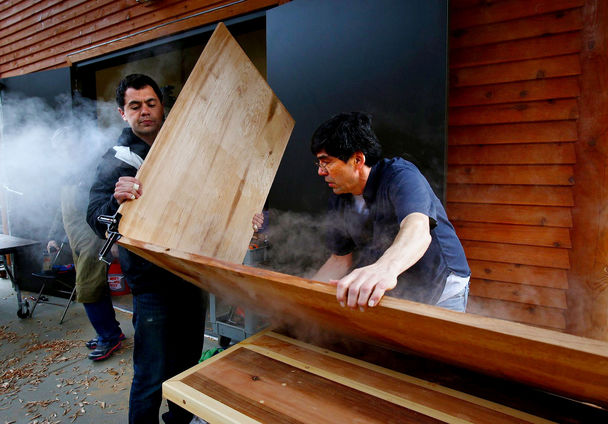The new carving shed at The Evergreen State College is hosting its first artist-in-residency program: carving cedar bentwood box drums.
Originally published April 7, 2013 at 8:09 PM
In the Seattle Times

The first class of students at The Evergreen State College’s new carving shed learned to make bentwood box drums from master carver David Boxley, center, over the weekend. Clifton Guthrie, left, puts a bend in his box drum after steaming the cedar board to soften the wood.
Mark Harrison / The Seattle Times
OLYMPIA —
It’s the scent that hits you first: cedar. Pungent yet sweet, overpowering and cleansing.
The source was soon obvious: a stack of gigantic, old-growth cedar planks, awaiting the first students in the new carving shed just opened at The Evergreen State College. They started Saturday and will spend the next two weekends with David Boxley, a Tsimshian master carver based in Kingston, Kitsap County, learning how to make cedar bentwood box drums.
The class is the inaugural program in the shed, built with part of a $500,000, three-year grant from the Ford Foundation. The shed is envisioned as the first of very big things to come at Evergreen, with the launch of a new master’s of fine arts degree program in indigenous arts, the only one of its kind in the Lower 48, said Tina Kuckkahn-Miller, director of the Longhouse Education and Cultural Center at Evergreen.
The carving shed is intended as the first building of more to come to house the program, she said.
Awe-struck by the big, beautiful planks, some of the students had to settle down before making their first cuts. It wasn’t just the wood — though a single slab of old-growth cedar more than 3 feet wide is an awesome material to work with. It was also the realization that carving in the tradition of their ancestors isn’t just any job.
“We are about to push our canoes out; don’t take this lightly,” Boxley said before beginning class.
“What you are about to do has been done for thousands of years. Wood is being bent for the right reasons. Not for commercial purpose, but for our ceremonies. To uplift our culture,” Boxley said.
“Try really hard. Don’t get frustrated. And at the end, hopefully there will be 10 box drums, ready to make some noise.”
In addition to hand tools, including heirloom handmade carving knives, carvers ripped into the big planks with circular saws to trim off rough edges.
Fred Fullmer, of Kirkland, a Tlingit artist, brought his granddaughter and another member of his dance group along to work on the box drum they hope to use in performing their songs and dances.
More commonly used by northern tribes to accompany ceremonial songs and dances, the box drum is a coveted novelty in Coast Salish country. Here, bentwood boxes are more familiar art pieces than box drums.
They are large, rectangular musical instruments made from a plank of cedar, steamed to bend it into a box shape.
Left open on one side, the box becomes a powerful drum, to be stood on one end, or, traditionally, hung from a rope of twined cedar bark. Struck with a hand or a padded beater, the box drum speaks with a deep resonant boom, louder and lower in tone than a skin drum.
Just carving the drum is fulfilling, Fullmer said, because it connects him with his ancestors.
“When I am carving I get to go through the same experiences they did,” he said. “To me, it is part of the fabric of our culture, it’s not just one thing, standing by itself. It’s all the pieces. The language, the songs, the dances, carving.”
Brandon Mayer, 17, of Shoreline, carefully unwound a canvas tool case to use his grandfather’s carving tools for the first time.
“What a thing to be part of. It’s a real honor to be preserving this art, bringing it back,” said Mayer, who is Haida and Tlingit.
Upper Skagit artist Peter Boome, of Tacoma, usually a print maker, said he was thrilled to have a chance to carve a bentwood box drum for the first time.
Every piece of art is a chance to inspire someone, Boome said. “Complacency isn’t an option.”
Lynda V. Mapes: 206-464-2736 or lmapes@seattletimes.com
